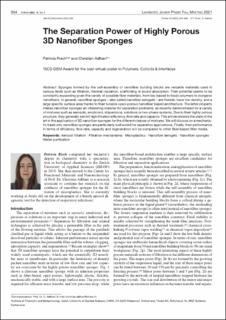Please use this identifier to cite or link to this item:
https://doi.org/10.21256/zhaw-24923Full metadata record
| DC Field | Value | Language |
|---|---|---|
| dc.contributor.author | Risch, Patricia | - |
| dc.contributor.author | Adlhart, Christian | - |
| dc.date.accessioned | 2022-05-06T13:24:15Z | - |
| dc.date.available | 2022-05-06T13:24:15Z | - |
| dc.date.issued | 2022 | - |
| dc.identifier.issn | 0009-4293 | de_CH |
| dc.identifier.issn | 2673-2424 | de_CH |
| dc.identifier.uri | https://digitalcollection.zhaw.ch/handle/11475/24923 | - |
| dc.description.abstract | Sponges formed by the self-assembly of nanofiber building blocks are versatile materials used in various fields such as filtration, thermal insulation, scaffolding or sound absorption. Their potential seems to be constantly expanding given the variety of possible fiber materials, from bio-based to fossil polymers to inorganic nanofibers. In general, nanofiber sponges – also called nanofiber aerogels – are flexible, have low density, and a large specific surface area thanks to their tunable open-porous nanofiber based architecture. The latter property makes nanofiber sponges an interesting material for separation problems, as recently demonstrated for a variety of mixtures such as aerosols, emulsions, dispersions, solutions or two-phase systems. Due to their highly porous structure, they generally exhibit high filtration efficiency, flow rate and capacity. This article reviews the state of the art in the application of 3D nanofiber sponges for the different classes of mixtures. We will discuss on a mechanistic basis why nanofiber sponges are particularly well suited for separation applications. Finally, their performance in terms of efficiency, flow rate, capacity and regeneration will be compared to other fiber-based filter media. | de_CH |
| dc.language.iso | en | de_CH |
| dc.publisher | Schweizerische Chemische Gesellschaft | de_CH |
| dc.relation.ispartof | Chimia | de_CH |
| dc.rights | http://creativecommons.org/licenses/by/4.0/ | de_CH |
| dc.subject | Aerosol filtration | de_CH |
| dc.subject | Filtration mechanism | de_CH |
| dc.subject | Microplastic | de_CH |
| dc.subject | Nanofiber aerogel | de_CH |
| dc.subject | Nanofiber sponge | de_CH |
| dc.subject | Water purification | de_CH |
| dc.subject.ddc | 660: Technische Chemie | de_CH |
| dc.title | The separation power of highly porous 3D nanofiber sponges | de_CH |
| dc.type | Beitrag in wissenschaftlicher Zeitschrift | de_CH |
| dcterms.type | Text | de_CH |
| zhaw.departement | Life Sciences und Facility Management | de_CH |
| zhaw.organisationalunit | Institut für Chemie und Biotechnologie (ICBT) | de_CH |
| dc.identifier.doi | 10.2533/chimia.2022.354 | de_CH |
| dc.identifier.doi | 10.21256/zhaw-24923 | - |
| zhaw.funding.eu | No | de_CH |
| zhaw.issue | 4 | de_CH |
| zhaw.originated.zhaw | Yes | de_CH |
| zhaw.pages.end | 360 | de_CH |
| zhaw.pages.start | 354 | de_CH |
| zhaw.publication.status | publishedVersion | de_CH |
| zhaw.volume | 76 | de_CH |
| zhaw.publication.review | Peer review (Publikation) | de_CH |
| zhaw.webfeed | Funktionsmaterialien und Nanotechnologie | de_CH |
| zhaw.funding.zhaw | BIOMAT (Integrated Bio-based Materials Value Chains) | de_CH |
| zhaw.funding.zhaw | Nanofaserbasierte Aerogele für ein Filtrationssystem in biotechnologischen Downstream Prozessen | de_CH |
| zhaw.funding.zhaw | Digitale Simulation zur individualisierten Fertigung von 3D Nanofaserfilter und Integration in Vollschutzanzug für Pandemiefälle | de_CH |
| zhaw.author.additional | No | de_CH |
| zhaw.display.portrait | Yes | de_CH |
| Appears in collections: | Publikationen Life Sciences und Facility Management | |
Files in This Item:
| File | Description | Size | Format | |
|---|---|---|---|---|
| 2022_Risch-Adlhart_Separation-Power-Nanofiber-Sponges_Chimia.pdf | 688.21 kB | Adobe PDF |  View/Open |
Show simple item record
Risch, P., & Adlhart, C. (2022). The separation power of highly porous 3D nanofiber sponges. Chimia, 76(4), 354–360. https://doi.org/10.2533/chimia.2022.354
Risch, P. and Adlhart, C. (2022) ‘The separation power of highly porous 3D nanofiber sponges’, Chimia, 76(4), pp. 354–360. Available at: https://doi.org/10.2533/chimia.2022.354.
P. Risch and C. Adlhart, “The separation power of highly porous 3D nanofiber sponges,” Chimia, vol. 76, no. 4, pp. 354–360, 2022, doi: 10.2533/chimia.2022.354.
RISCH, Patricia und Christian ADLHART, 2022. The separation power of highly porous 3D nanofiber sponges. Chimia. 2022. Bd. 76, Nr. 4, S. 354–360. DOI 10.2533/chimia.2022.354
Risch, Patricia, and Christian Adlhart. 2022. “The Separation Power of Highly Porous 3D Nanofiber Sponges.” Chimia 76 (4): 354–60. https://doi.org/10.2533/chimia.2022.354.
Risch, Patricia, and Christian Adlhart. “The Separation Power of Highly Porous 3D Nanofiber Sponges.” Chimia, vol. 76, no. 4, 2022, pp. 354–60, https://doi.org/10.2533/chimia.2022.354.
Items in DSpace are protected by copyright, with all rights reserved, unless otherwise indicated.